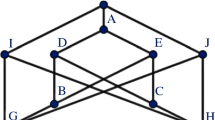Abstract
A simplicial complex is a set equipped with a down-closed family of distinguished finite subsets. This structure, usually viewed as codifying a triangulated space, is used here directly, to describe ‘spaces’ whose geometric realisation can be misleading. An intrinsic homotopy theory, not based on such realisation but agreeing with it, is introduced.
The applications developed here are aimed at image analysis in metric spaces and have connections with digital topology and mathematical morphology. A metric space X has a structure t ε X of simplicial complex at each resolution ε>0; the resulting homotopy group π n ε(X) detects those singularities which can be captured by an n-dimensional grid, with edges bound by ε this works equally well for continuous or discrete regions of Euclidean spaces. Its computation is based on direct, intrinsic methods.
Similar content being viewed by others
References
Adámek, J., Herrlich, H. and Strecker, G.: Abstract and Concrete Categories, Wiley Interscience Publ., New York, 1990.
Bak, A.: Global actions: the algebraic counterpart of a topological space, Uspekhi Mat. Nauk 52(5) (1997), 71–112. Russian Math. Surveys 52(5) (l997), 955-996.
Bak, A.: Topological methods in algebra. In: S. Caenepeel and A. Verschoren (eds), Rings, Hopf Algebras and Brauer Groups, Lecture Notes Pure Appl. Math. 197, M. Dekker, New York, 1998, pp. 43–54.
Borceux, F.: Handbook of Categorical Algebra, Vols. 1-3, Cambridge Univ. Press, Cambridge, 1994.
Brown, R.: Topology, Ellis Horwood, Chichester, 1988.
Cordier, J. M. and Porter, T.: Shape Theory, Ellis Horwood, Chichester, 1989.
Deheuvels, R.: Topologie d'une fonctionelle, Ann. Math. 61 (1955), 13–72.
Eilenberg, S. and Kelly, G. M.: Closed categories, In: Proceedings of the Conference on Categorical Algebra, La Jolla 1965, Springer, 1966, pp. 421-562.
Frosini, P. and Mulazzani, M.: Size homotopy groups for computation of natural size distances, Bull. Belg. Math. Soc. Simon Stevin 6 (1999), 455–464.
Grandis, M.: Cubical monads and their symmetries. In: Proceedings of the Eleventh International Conference on Topology, Trieste 1993, Rend. Ist. Mat. Univ. Trieste 25 (1993), 223–262.
Grandis, M.: Homotopical algebra in homotopical categories, Appl. Categ. Structures 2 (1994), 351–406.
Grandis, M.: Cubical homotopical algebra and cochain algebras, Ann. Mat. Pura Appl. 170 (1996), 147–186.
Grandis, M.: Categorically algebraic foundations for homotopical algebra, Appl. Categ. Structures 5 (1997), 363–413.
Grandis, M.: On the homotopy structure of strongly homotopy associative algebras, J. Pure Appl. Algebra 134 (1999), 15–81.
Hardie, K. A. and Vermeulen, J. J. C.: Homotopy theory of finite and locally finite T0 spaces, Expo. Math. 11 (1993), 331–341.
Heijmans, H. J. A. M.: Mathematical morphology: a modern approach in image processing based on algebra and geometry, SIAM Rev. 37 (1995), 1–36.
Hilton, P. J. and Wylie, S.: Homology Theory, Cambridge Univ. Press, Cambridge, 1962.
Kan, D. M.: Abstract homotopy II, Proc. Nat. Acad. Sci. U.S.A. 42 (1956), 255–258.
Kelly, G. M.: Basic Concepts of Enriched Category Theory, Cambridge Univ. Press, Cambridge, 1982.
Kong, T. Y., Kopperman, R. and Meyer, P. R.: A topological approach to digital topology, Amer. Math. Monthly 98 (1991), 901–917.
Kong, T. Y., Kopperman, R. and Meyer, P. R. (eds): Special issue on digital topology, Topol.Appl. 46(3) (1992), 173–303.
Mac Lane, S.: Categories for the Working Mathematician, Springer, Berlin, 1971.
Mardeši´c, S. and Segal, J.: Shape Theory, North-Holland, Amsterdam, 1982.
McCord, M. C.: Singular homology groups and homotopy groups of finite topological spaces, Duke Math. J.33 (1966), 465–474.
Milnor, J. W.: Morse Theory, Princeton Univ. Press, Princeton, 1963.
Nel, L. D.: Introduction to Categorical Methods, Parts 1-2, Carleton-Ottawa Lecture Note Series, Ottawa, 1991.
Puppe, D.: Homotopiemengen und ihre induzierten Abbildungen, I, Math. Z. 69 (1958), 299–344.
Spanier, E. H.: Algebraic Topology, McGraw-Hill, New York, 1966.
Street, R.: Categorical structures, In: Handbook of Algebra, Vol. 1, North-Holland, Amsterdam,1996, pp. 529–577.
Author information
Authors and Affiliations
Rights and permissions
About this article
Cite this article
Grandis, M. An Intrinsic Homotopy Theory for Simplicial Complexes, with Applications to Image Analysis. Applied Categorical Structures 10, 99–155 (2002). https://doi.org/10.1023/A:1014326730784
Issue Date:
DOI: https://doi.org/10.1023/A:1014326730784




